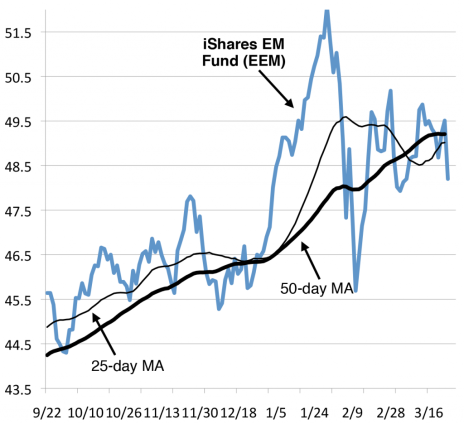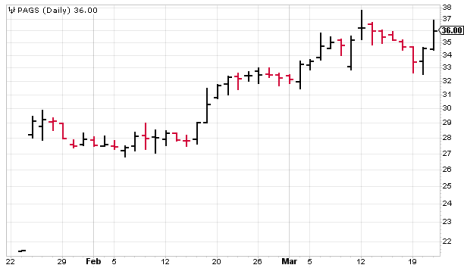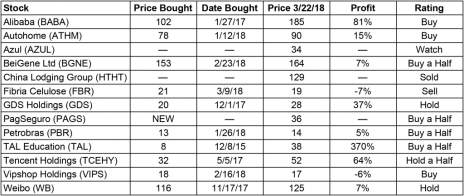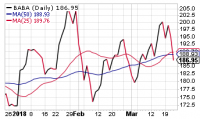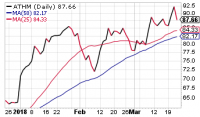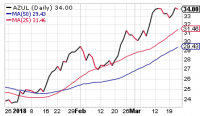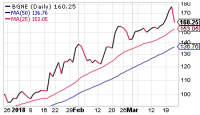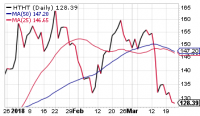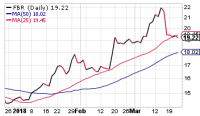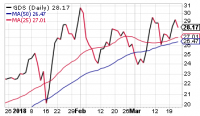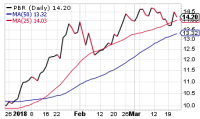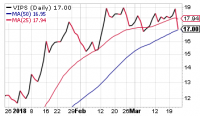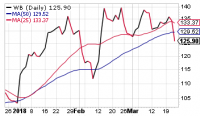The possibility of a trade war between the U.S. and China has dealt a blow to many Chinese stocks. Most of the damage is being done by withdrawals from China exchange-traded funds and broader emerging-market or ex-U.S. funds. But whatever the source, the reality is that we have a new warning signal from the Cabot Emerging Markets Timer.
Cabot Emerging Markets Investor 655
[premium_html_toc post_id="146940"]
Cabot Emerging Markets Timer
The Emerging Markets Timer is our disciplined method for staying on the right side of the emerging markets. The Timer is bullish when the index is above the lower of its two moving averages and that moving average is trending up.
Our Emerging Markets Timer is effectively on the fence, as the sector rests near the middle of its three-month trading range. Today’s sharp slide did bring the iShares EM Fund (EEM) below its 25-day and 50-day moving averages, but stepping back, the sector has seen plenty of ups and downs in recent weeks and is almost exactly halfway between its January high and February low. Thus, the intermediate-term trend is mostly neutral here, though it bears watching.
Because the longer-term trend is up and the higher lows formed since the early-February wipeout, we remain optimistic that the next big move is up. But until we see the buyers show some power, it’s best to take things on a stock-by-stock basis, holding your strong names but pruning any EM stocks that crack and keeping a little cash on the sideline.
Charting a Course in Uncertain Waters
Investors are not happy, so markets are not happy. It’s the way things are.
The long-running Russia investigation in Washington, D.C. shows no sign of being over, or even close to over, but it’s sucking up altogether too much of the town’s time and energy. And the (possibly) related Facebook hack and Cambridge Analytica exploits have torpedoed Facebook’s stock, with the Nasdaq as collateral damage.
The steel and aluminum tariffs haven’t really had an effect, yet, but investors are already worried about the imminent $50 billion round of tariffs to be imposed on Chinese goods and what China’s response might be.
And in the back of many investors’ minds, the changes in China—Xi Jinping’s accession to the role of permanent leader of China, massive buildups in the People’s Liberation Army (and its naval and air arms) and a stiffening of controls on public expression and dissent—are a worry that’s low-level but constant.
None of these worries is a market killer all by itself, though when investors are worried, they react more strongly to bad news, which can be a temporary momentum-buster.
But, as the old market proverb says, “Markets climb a wall of worry.” And despite all the uncertainties and the anxiety of investors, markets continue to hold up, especially non-U.S. markets.
Emerging market stocks, as represented by the iShares EM Fund (EEM), made a great run from early December through late January, soaring from 44 to 52. But the correction that followed pulled EEM back to 46 at the close on February 8. And EEM’s action since then has been indecisive, with the Fund trading in a tightening range under resistance at 50. The action, including EEM’s 25-day moving average dipping under its 50-day and a series of flips from positive signals to negative and back again, has made for choppy trading. The near-term trend is basically neutral at this point.
The situation with the Golden Dragon Fund (PGJ) that tracks Chinese ADRs is a bit more constructive in that PGJ is closer to its highs and, before today, had been holding above its moving averages for the past few weeks. But it, too, remains sloppy and choppy.
Given all that uncertainty and technical ambiguity, it’s good to remember that we use our timing indicator (the Cabot Emerging Markets Timer) as a guideline to adjust our level of aggressiveness or risk avoidance. The stocks in our portfolio are all handled on a case-by-case basis.
Our position in China Lodging (HTHT), the remaining half of which was sold last week after almost two years in the portfolio, is a good example. We sold the first half of HTHT in late November after a dip from 142 to 102 even though the Emerging Markets Timer was positive at the time. We allowed our big profit in the stock to keep us in the position, but reduced our exposure to lower the risk in case the stock’s drop continued. HTHT recovered to hit new highs at 166 in January, and it wasn’t until an earnings-related gap down to 132 on March 14 that we finally booked our 269% profit on the second half and moved on.
Back to the market, a continued news-driven, volatile environment wouldn’t be surprising given the dramatic headlines, hitting some stocks and benefiting others. The trick will be to remain agile and keep our eye on the winds of the market, shifting course and putting on more or less sail as the market directs.
Featured Stock
An Easier Way to Pay
PagSeguro (PAGS)
In the past couple of decades, U.S. shoppers have noticed that traditional cash registers are going the way of the dinosaurs in favor of credit card modems. And in just the past five years, give or take, more and more merchants have been using a little dongle on their cellphones or tablets to swipe cards as Square powered a revolution in point-of-sale (POS) payment options.
That payment revolution has gone international, with Paypal fighting it out in Brazil with local vendors like MercadoPago (which is MercadoLibre’s payment arm) in the online arena. Square is also aiming for a piece of the international payment pie, targeting the dedicated device market by virtually giving away its dongles and making its money primarily from transaction fees.
But an upstart Brazilian company, PagSeguro (which translates roughly to “secure pay”), has been quietly and quickly gaining an advantage on both its international and Brazilian competition, producing wildly rapid growth in the process.
PagSeguro is a creation of Brazilian media group Universo Online, which is in turn owned by Grupo Filha, a media conglomerate that owns the top newspaper in Brazil. Universo is also ranked as the biggest internet portal in Brazil, with 50 million unique visitors and almost seven billion page views per month.
PagSeguro was formed in 2006 to provide a financial services platform and grew quickly, taking over BrPay, an electronic payment company, soon after. The company had more than 12 million registered users by 2010 and grew further by acquiring a fraud prevention company and partnering with Nokia on a unique Near Field Communication technology that allows two cell phones to communicate securely when in proximity. And in 2013, PagSeguro launched its MINI credit- and debit-card reader, a hand-held device that uses wi-fi.
The target customer for the MINI system is a small company with no website or e-commerce presence. PagSeguro’s technology and alliances with banks give buyers and sellers a number of options for completing sales, and (importantly) the company guarantees the validity of sales and settles disputes.
PagSeguro’s revenue growth has been meteoric, with double-digit growth from Q2 2015 through Q3 2016 and triple-digit growth in the five subsequent quarters. Earnings growth has been at triple-digit rates since Q2 2016 with the most recent quarters showing 367% (Q3 2017) and 350% (in Q4) bottom line gains. (Fourth quarter results were reported on March 9.) After-tax profit margins have been growing quickly and have topped 20% in the two most-recent quarters. And the good times should continue to roll—analysts are estimating 2018 earnings growth at 111% and 41% in 2019.
PAGS is still just a baby, having come public on January 24 in an IPO that pulled in $2.3 billion. The stock hit 30 a couple of days after its IPO, then dipped to 27 on February 6, which is about as much of a post-IPO droop as we’ve seen so far.
The stock ripped to near 38 on March 12, but was back below 33—and right on its 25-day moving average—on Monday before bouncing again. A stock this young can be expected to exhibit considerable volatility, but there’s no mistaking investors’ enthusiasm for this strong story.
The Big Idea here is that Brazil, while it’s not as big a market as China, is still early in its integration of online purchases and payments into its economy. PagSeguro offers smaller businesses a secure way to make sales and get payments. And it’s likely that as the company grows, it will begin to offer bookkeeping, data-mining and financing services in imitation of Square’s evolution.
The word “disruptive” gets tossed around a lot these days, applied to companies that have come up with a marginal improvement to existing products or services. But PagSeguro’s business proposition is proving genuinely disruptive to existing Brazilian payment practices. And it will both promote and benefit from the further rollout of online commerce in that country. We’re buying a half-sized position for the portfolio tomorrow, and will look to average up should the stock get off to a good start and our Emerging Markets Timer flashes a green light. BUY A HALF.
PagSeguro (PAGS)
Avenida Brigadeiro Faria Lima, 1384
4º andar parte A
Sao Paulo, SP 01451-001
Brazil
55 11 3038 8127
http://www.pagseguro.uol.com.br
Model Portfolio
Invested 75% Cash 25%
Updates
Our Emerging Markets Timer is effectively neutral, and we’re seeing that play out among our recommended stocks, with a few looking great, a few looking iffy, and many just chopping around. As always, we’re holding our resilient performers, but we’re keeping laggards on tight leashes given the environment.
Tonight, we are moving two stocks to Hold—Tencent Holdings (TCEHY) and Weibo (WB) and selling one, Fibria Celulose (FBR). Details below.
Alibaba (BABA) had been showing signs of shaping up, though the market’s sloppy patch this week has pulled the stock back into its multi-month consolidation. We can’t say the stock’s multi-month rest period is definitely over, but we continue to feel the major uptrend is likely to resume eventually. If you don’t own any, we’re OK grabbing some shares here. BUY.
Autohome (ATHM) continues to act well after shakeout-and-recovery action following earnings two weeks ago. Given the tricky market environment, the stock is showing solid relative strength, and we like the steady earnings growth (20% this year, 24% next, both likely conservative) that analysts forecast. We’ll stay on Buy. BUY.
Azul S.A. (AZUL) remains perched near its highs, buoyed by the company’s bullish 2018 outlook from a couple of weeks ago, including a 17% to 20% increase in capacity and an expected one to two percentage point increase in its cash flow margin, which is leading analysts to forecast a 33% pop in earnings this year. Given the still-iffy Emerging Markets Timer, we’ll stay on Watch, but a consolidation or shakeout could provide a solid entry point. WATCH.
BeiGene (BGNE) has actually ramped to new highs on solid volume this week, bucking the choppy action of the overall market before today’s retracement. It’s speculative, but BeiGene has a slew of clinical data releases coming this year for three different drugs it’s researching, and anticipates progress on reimbursement from Chinese provinces for Celgene’s cancer treatment Abraxane, which it’s marketing in China. Look for dips of a few points to buy a small position. BUY A HALF.
It was a great, profitable run, but we bid farewell to China Lodging Group (HTHT) last week after the stock fell sharply on earnings, which came on the heels of some stalling action during the past few months. Eventually, if HTHT resets itself, we could always get back in. But at this point, the sellers are doing their work, and the stock likely needs time to digest its massive gains in recent years. SOLD.
We’re moving Fibria Celulose (FBR) to Sell, as the stock took a hit after the company agreed to merge with Brazil’s Susazo Papel e Celulose in what was a lesser offer than a competing bid from Netherlands-based Paper Excellence. The resulting company will be the world’s biggest wood pulp producer, which, in a global economic expansion, could prove fruitful. Still, we now have a loss and want to reduce our overall exposure, so FBR’s lackluster performance in the face of a definite conclusion to the buyout situation looks like a good way to shorten our sails. SELL.
GDS Holdings (GDS) remains choppy, holding above its 50-day line and just a couple of points from all-time highs. We want to give the stock every chance to hold up given its powerful growth story—the firm looks like another Equinix or Digital Realty, with its data centers proving increasingly popular for big players in China. The firm expects revenues and cash flow to rise 55% and 79% (respectively) this year as it opens up new data centers (including three it broke ground on in January alone). A break below 24 or so would be ominous, but right here, the stock is acting fine. Sit tight. HOLD.
Petrobras (PBR) pulled back to its 25-day line before bouncing, which looks like normal action. The company’s fourth-quarter report revealed its lowest net debt level since 2012, while administrative costs were slashed 19%. The turnaround looks real, and with oil prices holding firm in the mid 60s, the company’s bottom line should start perking up in Q1. BUY A HALF.
TAL Education (TAL) remains volatile but strong, holding above its 25-day line since mid-February. The current fiscal year (which began at the start of this month) is expected to show 62% earnings growth, which should keep buyers interested. Hold on if you own some, and if you don’t, we’re OK buy a half-sized position on dips of a point or two. BUY A HALF.
Tencent Holdings (TCEHY) reported a good fourth quarter this morning, with local currency revenues rising 51% from a year ago, which included a 32% gain in its online game business, a 49% hike in online advertising sales and a triple-digit boom in payment-related services. That said, the company made it clear that it would continue to spend heavily, which will likely constrain margins. Combined with the stock’s big run during the past 15 months and today’s crummy market, the shares took a hit. It’s not a disaster, but TCEHY has stalled out with resistance near 60 for a few weeks, and today’s selling is enough for us to move to Hold. If you have a loss, be careful not to let the loss grow. If you have a partial position with a big profit (like us), we advise holding on and seeing whether shares can etch a new base. HOLD A HALF.
Vipshop (VIPS) already went through the wringer during the past couple of years, so it’s a safe assumption that most of the current owners are true believers, which is a plus. The stock certainly acts that way—it’s formed a reasonable consolidation since mid-February and continues to hold firm. We don’t have a profit cushion, so a big-volume drop of two or three points could have us taking action. But looking at the fundamental (including its deals with JD.com and Tencent) and technical picture, we continue to think the next big move is likely up. You can grab some shares here if you’re not yet in. BUY.
We’re flipping Weibo (WB) to a Hold rating tonight. Despite the stock’s bullish earnings reaction in February, it’s been unable to get going above resistance at 140 and the sellers have recently shown up. It’s not the worst chart out there by any means, especially given the wobbly market, and the fundamental story (earnings up 56% this year and 43% next, both of which are probably conservative) remains outstanding, so we’re not panicking. But it’s prudent to switch to a Hold rating; we’ll be using a mental stop just below 120 (above our purchase price of 116) in case the selling intensifies. HOLD.
[premium_html_footer]
Send questions or comments to paul@cabotwealth.com.
Cabot Emerging Markets Investor • 176 North Street, Salem, MA 01970 • www.cabotwealth.com
All Cabot Emerging Markets Investor buy and sell recommendations are made in issues or updates and posted on the Cabot subscribers’ website. Sell recommendations may also be sent to subscribers as special alerts via email. To calculate the performance of the hypothetical portfolio, Cabot “buys” and “sells” at the midpoint of the high and low prices of the stock on the day following the recommendation. Cabot’s policy is to sell any stock that shows a loss of 20% in a bull market (15% in a bear market) from our original buy price, calculated using the current closing (not intra-day) price. Subscribers should apply loss limits based on their own personal purchase prices.
THE NEXT CABOT EMERGING MARKETS INVESTOR ISSUE IS SCHEDULED FOR April 5, 2018
We appreciate your feedback on this issue. Follow the link below to complete our subscriber satisfaction survey: Go to: www.surveymonkey.com/chinasurvey
Cabot Emerging Markets Investor is published by Cabot Wealth Network, an independent publisher of investment advice since 1970. Neither Cabot Wealth Network, nor our employees, are compensated in any way by the companies whose stocks we recommend. Sources of information are believed to be reliable, but they are in no way guaranteed to be complete or without error. Recommendations, opinions or suggestions are given with the understanding that subscribers acting on information assume all risks involved. © Cabot Wealth Network 2017. Copying and/or electronic transmission of this report is a violation of the copyright law. For the protection of our subscribers, if copyright laws are violated, the subscription will be terminated. To subscribe or for information on our privacy policy, visit www.cabotwealth.com, write to support@cabotwealth.com or call 978-745-5532.
[/premium_html_footer]


